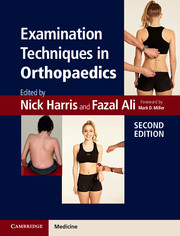Book contents
- Frontmatter
- Dedication
- Contents
- List of contributors
- Foreword
- Preface
- Acknowledgements
- 1 General principles of orthopaedic clinical examination
- 2 Examination of the shoulder
- 3 Examination of the elbow
- 4 Examination of the wrist
- 5 Examination of the hand
- 6 Examination of the peripheral nerves in the hand and upper limb
- 7 Examination of the adult spine
- 8 Examination of the hip
- 9 Examination of the knee
- 10 Examination of the foot and ankle
- 11 Examination of the brachial plexus
- 12 Orthopaedic examination techniques in children
- 13 Examination of the spine in childhood
- Index
- References
4 - Examination of the wrist
- Frontmatter
- Dedication
- Contents
- List of contributors
- Foreword
- Preface
- Acknowledgements
- 1 General principles of orthopaedic clinical examination
- 2 Examination of the shoulder
- 3 Examination of the elbow
- 4 Examination of the wrist
- 5 Examination of the hand
- 6 Examination of the peripheral nerves in the hand and upper limb
- 7 Examination of the adult spine
- 8 Examination of the hip
- 9 Examination of the knee
- 10 Examination of the foot and ankle
- 11 Examination of the brachial plexus
- 12 Orthopaedic examination techniques in children
- 13 Examination of the spine in childhood
- Index
- References
Summary
History
Patients with wrist problems often have a paucity of clinical signs. Specific provocative tests can be both difficult to perform and equivocal in their interpretation. A thorough history is therefore essential.
The history should start by recording the age, occupation and handedness of the patient, together with any affected recreational activities, including sports and hobbies.
The basic complaint needs to be established. Is it pain, weakness, a swelling, stiffness or a combination of these? Are there other symptoms? How long has there been a problem? Was there an injury or has the onset been insidious? What was the nature of the injury; was it a single event and, if so, did it receive treatment at the time?
The site and nature of pain should be established (Figure 4.1). The patient should be asked to try to localize it as accurately as possible (for example, by pointing). What is its nature; is it constant or intermittent, sharp, dull or ‘burning’? Is it worse with use and eased by rest? Are there particular movements that aggravate the pain such as turning taps, opening jars?
- Type
- Chapter
- Information
- Examination Techniques in Orthopaedics , pp. 42 - 52Publisher: Cambridge University PressPrint publication year: 2014



